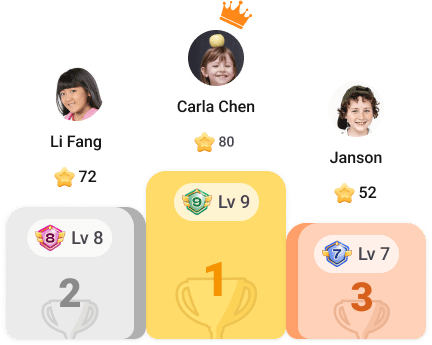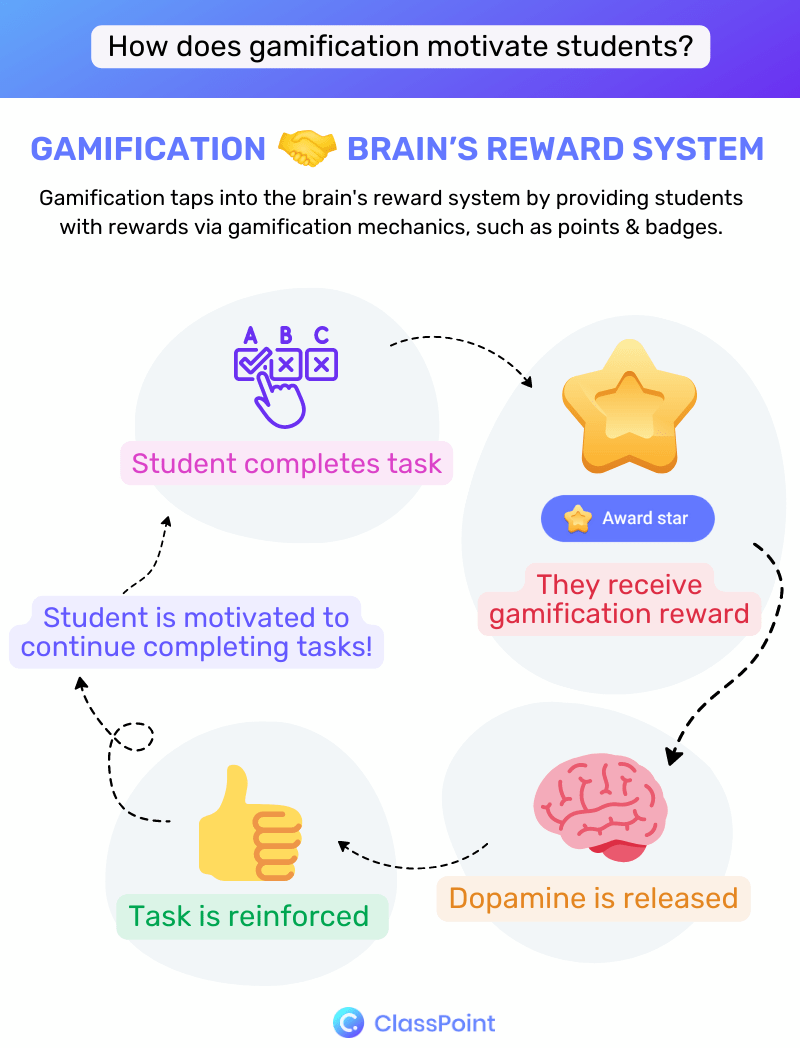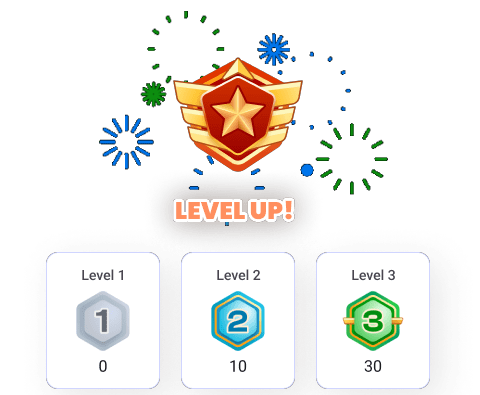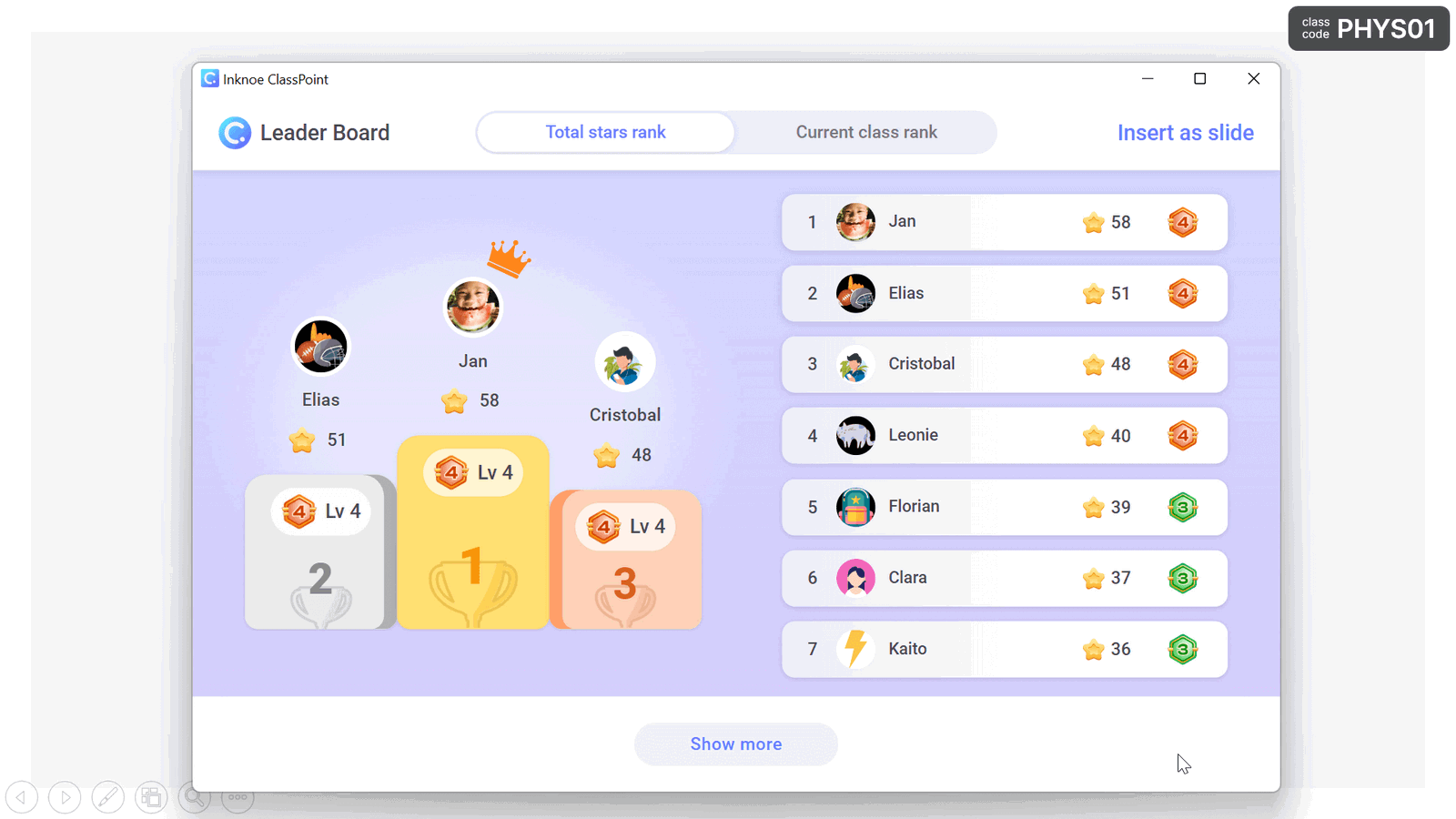As a teacher, one of the most challenging aspects of your job is motivating your students. Many factors can affect student motivation, including the difficulty of the subject matter, individual learning styles, and external distractions. Keeping students engaged and interested in learning is a constant battle, but what if there was a way to make it easier? That’s where gamification comes in.
Fortunately, gamification has emerged as a powerful tool for increasing student motivation in the classroom, and for good reason. Gamification can encourage student progress and motivate them to participate & learn. In this blog, we will explore how gamification increases student motivation, how gamification works, and how teachers can use gamification to improve their students’ learning experiences.
What is gamification?
Gamification is the use of game design elements, such as rewards and points, in non-game contexts, such as education. The goal of gamification is to make the learning experience more enjoyable and engaging by tapping into the brain’s reward system. When students are rewarded for their efforts, they are more likely to continue to engage in the learning process.

So, what is the difference between gamification and game-based learning? It’s important to note that they are not the same: game-based learning involves using actual games as the method to teach specific skills or concepts, while gamification involves incorporating game elements into non-game contexts. For example, a teacher might use a points system to motivate students to complete their homework, but that doesn’t mean the homework itself is a game.
Games and gamification both can lead to high levels of learner engagement and motivation.
Karl Kapp, a gamification guru and professor of Instructional Technology at Bloomsburg University
Why gamification increases student motivation
To understand why gamification is so effective at motivating students, let’s first look at the science behind motivation. Motivation is a complex process that involves the brain’s reward system. When we experience something pleasurable, such as eating a delicious meal or winning a game, our brains release dopamine, a neurotransmitter that is associated with pleasure and reward. This release of dopamine reinforces the behavior that led to the pleasurable experience, making us more likely to repeat it in the future.
Gamification taps into this reward system by providing students with immediate feedback and rewards for their efforts. When students earn points for completing tasks or badges for reaching milestones, their brains release dopamine, reinforcing the behavior and motivating them to continue. Science and research have shown how gamification increases student motivation, engagement, which leads to improved academic performance.

Research: From the study “Gamification in Education: A Systematic Mapping Study” by Pereira et al., gamification was found to improve students’ learning experiences by increasing engagement and motivation. The use of game mechanics show that gamification increases student motivation and sense of achievement. Additionally, the study found that gamification can be effective in promoting skills such as problem-solving, critical thinking, and collaboration.
Gamification also increases motivation by enjoyment, achievement, and competition:
Motivation by enjoyment
In addition to igniting the brain’s reward system, gamification can make learning more enjoyable and engaging. When students are having fun, they are more likely to be motivated to learn. By incorporating game elements into the learning experience, teachers can create a more immersive & interactive environment that encourages active participation. This engagement can increase motivation by making learning feel less like work and more like play.
Motivation by achievement
Rewarding students with gamification elements such as points, badges, and leaderboards can also motivate learners by creating a sense of achievement. Learners feel a sense of accomplishment when they earn points or badges, so gamification increases student motivation to keep learning to earn more rewards.
Motivation by competition
Gamification can also motivate by creating classroom competition. Leaderboards create a sense of competition by allowing learners to see how they rank compared to their peers. This competition can be a powerful motivator, especially for learners who are motivated by extrinsic factors.
🙋♀️ For example: a gamified math program might offer points for solving problems correctly, and bonus points for solving them quickly. The program might also have a leaderboard that shows students how they rank compared to their peers, which can motivate them to work harder and improve their skills. In this way, the gamified environment creates a sense of friendly competition that motivates students to do their best.
Gamification minimizes fear of failure
Gamification can also help minimize the fear of failure that many students experience when learning new material or facing assessments. Traditional education systems often focus heavily on academic achievement and test scores, which can create a high-pressure learning environment that increases students’ anxiety and stress levels. But gamification increases student motivation and reduces fear of failure by creating a low-stakes learning environment.
The consequences of failing are not so severe when learning is gamified, in fact, gamification transforms the narrative of failing because for most games, the only way to learn and progress in the game is to fail at it repeatedly and learn something each time. And with stimulating rewards, gamification motivates students to try new things and push themselves beyond their comfort zones, knowing that even if they fail, they can learn from the experience and continue to progress.
Gamification Mechanics
Gamification is made up of mechanics and techniques. Game mechanics are the fundamental building blocks of games, and they define the rules and actions that drive gameplay and student motivation. While gamification techniques, are the strategies teachers use to incorporate game mechanics into lessons to provide incentive for participation.
Check out these 4 gamification techniques & elements that you can use in your classroom to make learning more immersive & engaging.
As for gamification mechanics, here are some of the most common gamification techniques used in education:
Points
Points are the main mechanic of gamification. They provide immediate feedback, satisfaction, and reinforce positive behavior. Students can be given points as rewards for completing tasks, participating in discussions, and achieving learning goals. For example, a student might earn points for correctly answering a quiz question. These rewards can be used to unlock new levels, achievements, or badges.
Leaderboards
Leaderboards are a popular gamification technique that encourages friendly competition among students. They display the top-performing students, ranked by their scores or points, and can be used to motivate students to work harder & improve their skills.
Badges
Another token of achievement: Badges. Badges are a visual representation of a student’s achievements, and can motivate them to explore new topics, push themselves to learn more, and gain a sense of pride in their accomplishments. They can be awarded for completing tasks, mastering skills, participating in activities, or for reaching new progress levels.
Competitions
Competitions create excitement! And, they motivate students to engage with learning material. Competitions can be individual or team-based, and can be designed to be as simple or complex as the teacher wants, and they can be used for a variety of subjects.
Missions
Missions provide students with a sense of purpose and direction. They give students a clear objective to work towards, and can help students see the relevance of the material they are learning. Goals & missions can be used to break down larger learning objectives into smaller, more manageable tasks, and can be used to track progress and provide feedback to students.

Tie it to an objective 🤝
You can take the best gamification techniques and implement them into your classroom, but without setting clear objectives, students won’t be motivated to learn or progress, and both you and your students time will be wasted. Points awarded need to be tied to an achievable and identified learning objective and thus provide feedback on their progress & mastery of that objective.
How to Implement Gamification into your classroom
There are many strategies to implementing gamification, so let’s go over a helpful set of steps that that a teacher can take to implement gamification in their classroom:
1. Set learning objective
The first step is to identify the learning goals and objectives that you want to achieve. This will help you determine which gamification strategies to use and how to incorporate them into your teaching. And, this will set clear objectives for your students on what it is you are expecting them to achieve.
2. Decide game techniques & mechanics
The next step is to choose what kind of gamification strategy and game mechanics are best suited for your students’ objective & the actions they will need to complete to get there. Ask: Can you assign points to tasks? Is revealing a leaderboard fitting? Should you make a competition out of it?
3. Choose the best gamification tool
There are many online tools and platforms that can be used to gamify learning, such as ClassPoint, Quizlet, and Classcraft. These tools can make it easy to incorporate game mechanics into your lessons and track student progress. You can also use physical classroom resources to create printed badges or a leaderboard system on your wall.
4. Provide Rewards
First explain to students what their goal is and how they can earn stars and make progress towards that goal. Then provide the rewards via the game mechanics you choose.
5. Evaluate and adjust
It’s important to evaluate the effectiveness of your gamification strategies and make adjustments as needed. This can be done through student feedback, assessments, and observations.
For Example:
A history teacher’s goal is to improve active learning and understanding of their students when covering new material. They want students to showcase their understanding through different check points, answering questions, and participating in discussions, so they decide to use a point system and a leaderboard to motivate via healthy competition. Because they use PowerPoint slides to introduce new concepts, they add ClassPoint, a free Microsoft PowerPoint plug in, to their PowerPoint presentations. With ClassPoint’s star reward gamification system, the teacher gives students star points whenever 1. they answer understanding check points correct, 2. participate in topic discussions, or 3. they ask a good question. The teacher reveals the current class leaderboard during each session; and the students’ progress is reinforced by the stars, and they are motivated by the level badges they earn and the leaderboard display.

Conclusion
In conclusion, gamification is a powerful tool for educators to engage and motivate their students. By tapping into the brain’s reward system and incorporating mechanics such as points, leaderboards, badges, competitions, and missions, gamification increases student motivation. Overall, gamification provides a fun, engaging, and rewarding learning environment that inspires students to learn and grow.
If you teach with PowerPoint, check out how ClassPoint’s gamification point system, which is embedded right into PowerPoint, can help motivate your students and gain active participation during your lesson.

